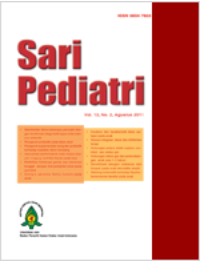Terapi Inhalasi pada Asma Anak
Sari
Pemberian obat pada asma dapat berbagai macamn cara yaitu parenteral, per oral, atau
perinhalasi. Pemberian per inhalasi adalah pernberian obat secara langsung ke dalam
saluran nafas melalui penghisapan. Pernberian obat secara inhalasi mempunyai beberapa
keuntungan yaitu obat bekerja langsung pada saluran nafas, onset kerjanya cepat, dosis
obat yang digunakan kecil, serta efek samping yang minimal karena konsentrasi obat di
dalam darah sedikit atau rendah. Pemberian aerosol yang ideal adalah dengan alat yang
sederhana, mudah dibawa, tidak mahal, secara selektif mencapai saluran nafas bawah,
hanya sedikit yang tertinggal di saluran nafas atas serta dapat digunakan oleh anak,
orang cacat atau orang tua. Namun keadaan ideal tersebut tidak dapat sepenuhnya tercapai
dengan adanya beberapa keuntungan dan kerugian masing-masing jenis alat terapi
inhalasi. Terapi inhalasi dapat diberikan dengan inhaler dosis terukur (metered dose
inhaler=MDI), MDI dengan bantuan spacer, nebulizer, intermitten positive pressure
breathing, rotahaler, atau diskhaler. Jenis terapi inhalasi di atas mempunyai keuntungan
dan kerugian masing-masing. Keberhasilan terapi inhalasi ditentukan oleh indikasi, cara
pemilihan obat, jenis obat, dan cara pemberiannya. Pada asma anak, baik tatalaksana
serangan (Pereda, reliever) maupun tatalaksana jangka panjang (pengendali, controller)
sangat dianjurkan penggunaan secara inhalasi. Penggunaan terapi inhalasi merupakan
pilihan tepat pada asma karena banyak manfaat yang didapat seperti onset kerjanya
cepat, dosis obat kecil, efek samping minimal, dan langsung mencapai target. Namun
demikian, terapi inhalasi ini mempunyai beberapa kendala yaitu tehnik dan cara
pemberian yang kurang tepat sehingga masih banyak yang tidak menggunakannya.
Dengan mengetahui hal di atas diharapkan pengobatan asma mencapai kemajuan yang
cukup berarti.
Kata Kunci
Teks Lengkap:
PDFReferensi
Lenfant C, Khaltaev N. Global initiative for asthma.
NHLBI/WHO Workshop Report 1995
Warner JO, Naspitz CK. Third International Pediatric
Consensus Statement on the Management of Childhood
Asthma. Pediatr Pulmonol 1998; 25:1-17.
Huchon, G. Metered dose inhalers past and present: Advantages
and limitations. Eur Respir Rev 1997; 7:26-8.
Matthys H. CFCs and their effect on the ozone layer:
the Montreal Protocol and consequences for physicians.
Eur Respir Rev 1997; 7:29-31.
June D. Achieving the change: challenges and successes
in the formulation of CFC-free MDIs. Eur Respir Rev
; 7:32-4.
Newman SP. New aerosol delivery system. Dalam: Barnes
PJ, Grunstein MM, Leff AR, Woolcock AJ, Asthma.
Philadelphia: Lippincott-Raven, 1997. h. 1805-15.
Reiser J dan Warner JO. Inhalation treatment for asthma.
Arch Dis Child 1986; 61:88-94.
Barry PW, Fouroux B, Pederson S, O’Callaghan C.
Nebulizers in childhood. Eur Respir Rev 2000; 10: 527-
Dolovich MB, Everard ML. Delivery of aerosols to children:
devices and inhalation techniques. Dalam: Naspitz
C, Szefler SJ, Tinkelman D, Warner JO. Textbook of
pediatric asthma. An International Perspective. London:
Martin Dunitz Ltd 2001. h. 327-46.
Malmstrom K, Sorva R, Silvasti M. Application and efficacy
of the multidose powder inhaler, easyhaler, in children
with asthma. Pediatr Allergy Immunol 1999; 10:66-70.
Kanner RE, Kanter LJ, Dwork P. A comparison of drug
delivery from a metered-dose inhaler plus an inspiratory
flow control device with a metered-dose inhaler plus a
spacer device. J Allergy Clin Immunol 1997; 99:853-4.
Bertrand P, Aranibar H, Castro E, Sanchez I. Efficacy of nebulized
epinephrine versus salbutamol in hospitalized infants
with bronchiolitis. Pediatr Pulmonol 2001; 31:284-8.
Freenhandler M, Asperen PPV. Nebuhaler versus nebulizer
in children with acute asthma. Br Med J 1984; 288:
-4.
Leach C. Safety assessment of the HFA propellant and
the new inhaler. Eur Respir Rev 1997; 7:35-6.
Bleecker E. Clinical reality: the safety and efficacy of the
world’s first CFC-free MDI. Eur Respir Rev 1997; 7:37-9.
Kamps AWA, van Ewijk B, Roorda RJ, Brand PLP. Poor
inhalation technique, even after inhalation instructions, in
children with asthma. Pediatr Pulmonol 2000; 29:39-42.
Fok TF, Lam K, Cheung Ng P, dkk. Aerosol delivery to
non-ventilated infants by metered-dose inhaler: should a
valved spacer be used? Pediatr Pulmonol 1997; 24:204-12.
Pederson S. Aerosol treatment of bronchoconstriction
in children, with or without a tube spacer. N Engl J Med
; 308:1328-30.
Barry PW. In vitro comparison of the amount of
salbutamol available for inhalation from different formulations
used with different spacer devices. Eur Respir
J 1997; 10:1345-8.
Rubilar L, Castro-Rudriguez JA, Girardi G. Randomized
trial of salbutamol via metered-dose inhaler with spacer
versus nebulizer for acute wheezing in children less than 2
years of age. Pediatr Pulmonol 2000; 29:264-9.
Nikander K, Turpeinem M, Wolmer P. Evaluation of
pulsed and breath-syncrinized nebulization of budesonide
as a means of reducing nebulizer wastage of drug. Pediatr
Pulmonol 2000; 29:120-6.
Ahonen A, Leinonen M, Pesonen MR. Patient satisfaction
with easyhaler compared with other inhalation system
in the treatment of asthma: A meta- analysis. Current
Theraupetic Research 2000; 61:61-73.
UKK Pulmonologi IDAI. Konsensus Nasional Penanganan
Asma pada Anak. Jakarta, 2000
Schuch S, Johnson DW, Callahan S, Canny G, Levison
H. Efficacy of frequent nebulized ipratropium bromide
added to frequent high-dose albuterol therapy in severe
childhood asthma. J Pediatr 1995; 126:639-45.
Nuhoglu Y, Bahceeiler, Barlan IB, Basaran MM. The
effectiveness of high-dose inhaled budesonide therapy
in the treatment of acute asthma exacerbations in children.
Ann Allergy Asthma Immunol 2001; 86:318-22.
Rabe KF, Vermeire PA, Soriane JB, Maier WC. Clinical
management of asthma in 1999: the Asthma insights
and reality in Europe (AIRE) study. Eur Respir J 2000;
:802-7.
Condemi JJ, Chervinsky P, Goldstein MF, dkk. Fluticasone
propionate powder administration through diskhaler versus
triamsolone acetonide aerosol administered through
metered-dose inhaler in patients with persistent asthma. J
Allergy Clin Immunol 1997; 100: 468-74.
Allen HDW, Thong IG, Clifton-Bligh P, Holmes S, Nery
L, Wilson KB. Effects of high-dose inhaled corticosteroids
on bone metabolism in prepubertal children with
asthma. Pediatr Pulmonol 2000; 29:188-93.
Kemp JP, Skoner DP, Szefler SJ, Walton-Bowen K, Rivera
MC, Smith JA. Once-daily budesonide inhalation suspension
for the treatment of persistent asthma in infants
and young children. Ann Allergy Asthma Immunol
; 83:231-9.
Szefler SJ. A review of budesonide inhalation suspension
in the treatment of pediatric asthma. Pharmacotherapy
; 21:195-206.
DOI: http://dx.doi.org/10.14238/sp4.2.2002.67-73
Refbacks
- Saat ini tidak ada refbacks.
##submission.copyrightStatement##
##submission.license.cc.by-nc-sa4.footer##
Email: editorial [at] saripediatri.org


Sari Pediatri diterbitkan oleh Badan Penerbit Ikatan Dokter Anak Indonesia
Ciptaan disebarluaskan di bawah Lisensi Creative Commons Atribusi-NonKomersial-BerbagiSerupa 4.0 Internasional.





